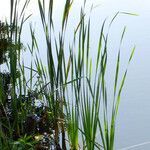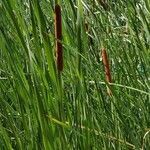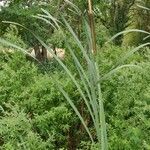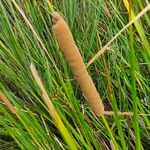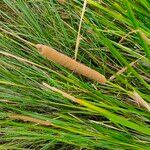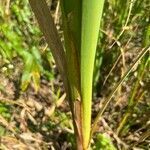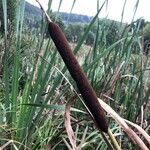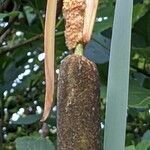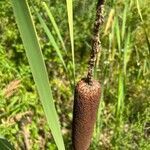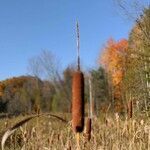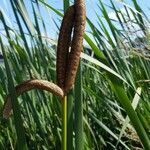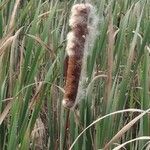Robust. Stem terete, 1½-3 m high. Leaves linear, tapering in their apical part, rather acute, 8-22 cm by 6-16 mm, very convex beneath, by longitudinal and transverse septa divided into a great number of aeriferous compartments; their upper surface canaliculate at the base, higher up flat; their base very markedly sheathing. ♂ Spike 15-30 cm long, longer than the female one, separated from it by an interval of ½-12 cm, very rarely contiguous to it, its rachis very distinctly compressed, tapering in the upper part, without excrescences, densely clothed with longish, ± woolly hairs, the rachis persistent till long after the fall of the ♂ flowers but at last falling off. Stamens 2-3 on a minute common stalk, intermixed with narrowly linear or narrowly spathulate hairs; the apex of these often broadened, entire or shortly toothed; anthers linear; connective shortly produced, rounded; pollen-grains free. ♀ Spike 1 or not very rarely 2 superposed, close together, cylindrical, oblique or rounded at the base, rounded at the top, 7-28 cm long, when ripe 2-2½ cm thick, darkbrown, cushion-like; excrescences on its axis at best 1 mm long. Flowers intermixed with very many bracteoles; these very variable, filiform with a more or less thickened, entire or often toothed-acuminate, brown or brownish apex, either exceeding the slightly brown-tipped hairs of the gynophore and then their apex visible on the outside of the spike or shorter and then hardly or not at all visible externally; hairs on the base of the gynophore rather close-set, white. Style longish; stigma flattened, lanceolate, acute, often curved. Fruit with an acute base and broader obtuse or subtruncate apex.
Stems 1–1.5 mm; lvs 5–11 mm wide, auriculate at the juncture of sheath and blade; pistillate and staminate portions of the spike separated by (1–)2–12 cm, the pistillate portion deep brown, 10–20 cm, 1–2 cm thick at maturity; compound pedicels short and stout; pistillate fls each accompanied by a hair-like bracteole with an expanded, flat, spatulate tip; stigma linear; fr 5–8 mm, subtended by copious hairs with a slightly expanded brown tip, the achene usually distinctly above the middle; sterile pistillate fls about as long as the fertile ones, dilated into a cuneate truncate tip; staminate bracteoles brown and scale-like; pollen in monads; 2n=30. Marshes, more tolerant of salt and alkali than no. 1 [Typha latifolia L.]; nearly cosmop., and throughout our range, the common sp. along the coast, now becoming common inland as well.
Stems 1.5-3 m tall, stout. Leaves 52-120 cm × 4-9 mm, abaxially convex, transverse section semicircular. Male part of spikes ca. 8 cm, with 1-3 deciduous bracts; female part of spikes (5-)15-30 cm, separated from male part by an axis 2.5-7 cm. Male flowers: stamens 3, rarely 2 or 4; anthers ca. 2 mm. Female flowers with bracteoles; bracteoles filiform; ovary fusiform; stalk ca. 5 mm, slender; styles 1-1.5 mm; stigmas linear to lanceolate, 1.3-1.8 mm; hairs on stalk shorter than style. Fruit narrowly elliptic. Fl. and fr. Jun-Sep. 2n = 30.
An erect marsh plant. It keeps growing from year to year. It is slender and grows about 1.2 m high. The leaves are narrow. They are 1 cm wide. They sheath the base of the stem. The flowers are small. They are crowded into a long, brown, cylindrical spike. This is 1.3-2 cm thick. The male and female flowers are separated by a gap of about 2.5 cm.
Plants 1-3 m. tall. Leaves narrowly ensiform, 0.3-1.0 cm. broad. Staminate and pistillate spikes of the inflorescence usually separated by a portion of naked peduncle, the pistillate less than 2 cm. in diameter; pistillate flowers usually having hair-like bractlets with dilated tips
